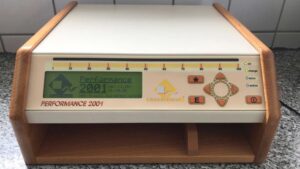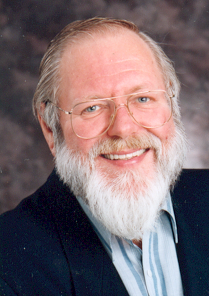“Performance 2001”
“Personally, I have been using the Performance 2001 as my exclusive practice point/meridian assessment and medication test instrument for almost three years – even though I have several “EAV” units like MORA- Super and RM-10/S which I previously used for decades, as well as an original Dermatron and “Vegatest” equipment. My already respectable therapeutic success has vastly improved since then, due to point and med-testing using the patient’s subtle inherent meridian potentials, instead of unnatural readings based on induced galvanic current resistance measurements. I’ve come to rely on my “2001” so much that I have an extra one on hand along with a spare electrode, just in case something goes wrong with my practice unit (which so far hasn’t happened).” WDS

At a recent meeting in Germany (April 2003), I summarized some tips and hints for accurate and reproducible use of the “Performance 2001” instrument from my three years experience with it clinically, and helping those Affiliates who have acquired one to get started properly. If you have not been using your unit in practice, I hope these hints and tips help you “get going” again.
(1) DO NOT use the gold-plated hand electrode. Because of dissimilar metals between hand electrode and the AgAgCl measurement tip there appears to be a bimetallic element effect, that likely will never yield truly accurate and reproducible measurements.
(2) Use the special clamp electrode with an AgAgCl alloy oval electrode plate that goes onto the inner (palmar) aspect of patient’s wrist on any side of the body, even on the hand being measured (since distance between measurement tip and reference hand electrode is not important like it is in “EAV”, etc.)
(3) Use the recommended (blotter-like) medical “Electrode Paper” as known from electrophysiology [O.I.R.F. sells it in packages containing 200 sheets of approximately 2 inch by 2 inch paper for about US $20 for 3 packs, including postage, or obtain from medical goods and equipment supplier]. If they do not know what you are talking about, tell them it is “contact medium of low alkalinity for limb electrodes”.
Thoroughly moisten both sides of paper with isotonic saline solution (not dripping wet!) and place it between clamp electrode and patient’s skin at the inner (palmar) surface of the wrist. Check occasionally and replace with new moistened paper before it gets too dry – which would change measurements somewhat because of resulting decline in conductivity as it becomes dry. Electrode paper is a must use item in “2001” work with the AgAgCl clamp reference electrode and of course electrophysiology in general.
(4) If still possible, get the newer “pressure constant” measurement probe with AgAgCl electrode tip! The newer probe offers better reproducibility than the original “adjustable probe tip penetration depth” one. If no longer available, don’t despair – I worked successfully with the original for over a year.
As you may know, the “2001” does not even start the process of measurement point “sampling” unless constant pressure has been achieved (about 100 pond = ca 100 grams)! This sampling process is done automatically by the “2001” unit in nanoseconds – averaged point measurement shows on display when 80 consecutive samplings are taken within 5 or so nanoamperes of each other.
(5) Preparation suggestions for AgAgCl tip and clamp electrode plate:
(a) Each day before first patient carefully soak measurement probe’s tip (only!) in distilled water for a few minutes. Apply few drops of distilled water on clamp electrode plate and dry – repeat this several times. The distilled water loosens/removes dried up saline solution crystals embedded in “craters” of AgAgCl alloy material, which prevent the tip and clamp electrode plate from retaining saline solution. (Look at your probe tip with a magnifying glass to see what I mean about “craters” – like on the moon.)
(b) Then, again daily before the first patient, repeat procedure (a) above, using isotonic saline solution. For convenience, I use sterile saline contact lens rinse solution like CIBA Vision® [without thimerosal] with a dispensing spout on bottle. This “awakens” the AgAgCl electrode material for the rest of that day’s patient measurements.
Moisten point electrode tip on gauze saturated (but not dripping wet!) with isotonic saline solution, before each and every new point measurement! The word “new” in the previous line refers to all further points, other than one that is immediately remeasured due to having slipped off or unretained low nanoampere readings [below 60 or 70 nanoamperes], where sufficient point moisture likely already exists. Ideally the gauze (100% round cotton pads as used in beauty care, work great for me) is placed into the bottom of a little glass container, such as a small breakfast jam cup [O.I.R.F. has these available from Med-Tronik in Germany; listed as a “swab dish”].
For quick access and convenience I keep this container in my left palm during the entire test, and with my right hand holding the measurement probe, touch its electrode tip onto the gauze to moisten it. This works very well, and helps remind me to moisten the tip before each and every new point measurement, when I really get flying.
For expediency purposes, I usually only measure the meridian terminal (Ting) points, on both hands and feet [automatically recorded and displayed on the faceplate of the “2001”, without the need for an external computer or software]. Based on those forty measurements, I reach an initial evaluation of the patient’s energetic situation and then do medication testing on appropriate high and low (above and below average nanoampere range) reading points. [See recent April 2003 mailing to O.I.R.F. Affiliates for an excellent article on “2001” average, high and low point reading definitions in nanoamperes.]
(c) For evaluation of nanoampere point and medication test readings, forget everything you know about EAV-type point and med-test interpretation! I beseech you to only use concepts based on measurement of the patient’s own point and meridian potentials, rather than trying to apply those of “EAV” induced galvanic current resistance measurements. By far the greatest problem encountered with unsatisfied owners – who otherwise are doing everything right as to AgAgCl tip and clamp electrode preparation – is their continued use of old EAV concepts for “2001” point evaluation and med-test interpretation.
I truly hope these notes convince you to start using your “Performance 2001” again if it has been sitting idle because you weren’t happy with reproducibility of measurements or its use in medication testing. Frankly, that instrument has greatly improved my patient evaluation and therapeutic success, compared to the already very good results I achieved previously during two decades of using “EAV”-type testing.
 An exclusive article for Affiliates
An exclusive article for Affiliates
From THE BRIDGE Newsletter of OIRF
Published July 7, 2003
© Copyright 2003, Dr. Walter Dr. Sturm, OIRF



